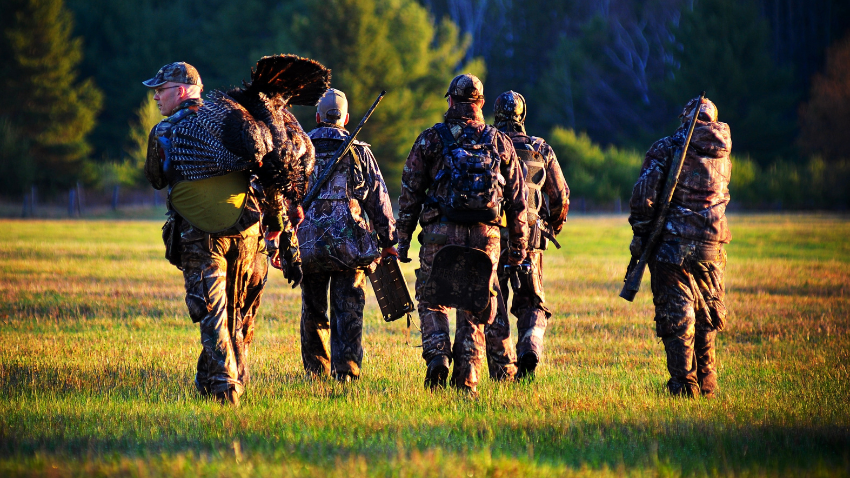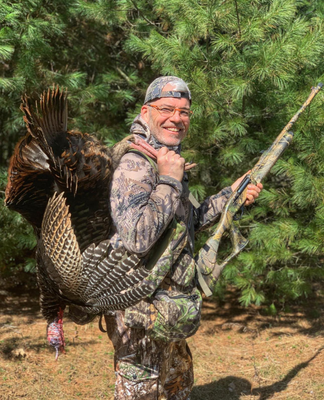8 tips and tricks for wild turkey hunting
- Posted on
- By Daniel Larocque
- Posted in Hunting, Tips and tricks, Wild turkey
- 0

Discover 8 tips and tricks for a successful spring wild turkey hunt. From arriving early to identifying roosts, these tactics will make your hunt easier and more successful.
8 Wild Turkey Hunting Tips and Tricks
Spring turkey hunting is one of my favorite seasons of the year. Since the opening of this hunt in our region, I have learned a few tips and tricks that have made turkey hunting easier and more successful for me. Most of my wild turkey hunts have been in Quebec and Ontario. I hope some of these tactics can be useful to you as well.
-
First of all, better to be early than late.
I always try to set my alarm 30 minutes earlier than my calculated time to get to the roost tree area, so that I can be in my position at least 30 minutes before the first call of the hens or the first call of a Tom. Being ahead will never work against you. Try as much as possible to avoid setting up facing east. The rising sun puts you at a disadvantage for sight and your camera lenses and optics can often reflect.
-
Carry more calls than necessary.
It is good to have several diaphragms, slates with a variety of call sticks and boxes, as sometimes the birds will particularly appreciate one call or another. Don't be afraid to use a male call, but be very careful using a Tom's call on public land.

-
Location calls
Locating calls such as the coyote howl, owl or crow call don't have to sound exactly like the natural thing to be effective in getting birds to gobble into the roost.
Remember, you're looking for a shocking response, so sometimes the worst scream you can do will be the best to get a Tom to respond. Even geese calls manage to shock the males. Especially if you are on a migratory route like with us. Enough that when I hear a big flock of geese coming, I keep my ears open or I use this moment to make my approaches and relocations.
-
Identify where they roost.
When locating a Tom in the evening, I make sure to try to identify the exact tree it is perched in. I then plan my installation for the morning.
-
Once on the ground
If the Tom(s) doesn't seem to want to engage, get as close to the Tom's position as possible without being spotted. Often, I can make 3 or 4 approaches and little by little manage to enter his bubble to make him trip and decide to visit me. The recipe for success for this technique is to have as much visual as possible to see their reactions. So moving is critical and must be done one step at a time using binoculars.
Once near a Tom , settle down before starting your calls because if he decides to come in, it can be done quickly.
If ever a female responds to your female calls aggressively, always cut her off by using the Yelp, female call by turning up the volume. A turkey box call is great for this scenario. If she persists, do not let go as she may want to escort you out of her territory by coming to tell you of her displeasure. If she is accompanied by a male, he will not be far behind.

-
Your clothes and equipment
Your clothing and gear should be comfortable and allow you to be highly mobile, quiet, well camouflaged, and protected from the elements. Here are some clothing and accessories that I recommend for turkey hunting:
CLOTHING
- Turkey Vest
- Pants
- Jacket and jersey
- Underlayers (Depending on the weather, be dressed in layers as the sun can get hot in the spring).
- Boots
- Gloves
- Caps and masks (if your jersey does not already have an integrated mask)
EQUIPEMENT
- Wild turkey calls
- Decoys
- Coyote Howler
- Binoculars
- Knife and pruner
- Folding turkey seat
- Flashlight or headlamp
- Seat cushion (if your Turkey vest does not already have its built-in cushion seat).
- Shotgun and ammunition
- Bow or crossbow
- Thermacell (bug repeller)
- Watkins (mosquito repellent lotion)
- Toilet paper :)
-
Bring food
Don't forget a lunch and a drink because hunting wild turkeys from 4 a.m. to noon makes you hungry and you'll need to refuel.
-
Be protected from bugs
In spring, mosquitoes, black flies and ticks can be very invasive. It is important to protect yourself well because without it we become too restless, uncomfortable and our movements are detected long before the expected encounter with a turkey. I personally use the miraculous Thermacell and Watkins.
Where can wild turkeys be hunted in Canada?
Thanks to successful wildlife restoration efforts and the wild turkey's ability to adapt to new habitats, turkey hunting is now permitted in British Columbia, Alberta, Manitoba (for residents only), Ontario and Quebec for Canadian hunters. Although wild turkeys can also be found in other provinces, their hunting there is currently illegal. Please make sure to verify the rules and regulations in your region of interest.
In conclusion, turkey hunting is a great way to get out into the wild, challenge yourself, and bring home some tasty meat. If you keep these tactics in mind, you'll have a much better chance of harvesting a turkey this spring.
Happy hunting and good luck!
Daniel Larocque



Comments
Be the first to comment...